Scuba masks are crucial diving equipment. It protects your eyes from saltwater and it allows you to see clearly underwater. Also, it must be leak-proof and reliable even under intense pressure. For this post, we will review two options for the best scuba mask for small faces together with a comprehensive buying guide.
Take note snorkel masks are different from dive masks. Below, we discussed these points in detail to help you purchase the right mask for your next plunge.
What is a Scuba Mask?
A scuba mask creates an air pocket in your face so you can breathe and see clearly. It also keeps underwater elements from getting into your eyes and nose to prevent irritation.
A diver’s choice of mask will directly affect the comfort of diving. A very tight one may cause facial barotrauma while a loose one will result in leaks.
Most of all, your scuba diving mask will dictate how much you’ll enjoy the underwater dive. You must get one with a clear lens that doesn’t fog up easily. Also, you should choose the lens type that suits your underwater activities.
Another thing that you have to consider is the fit of the dive mask you’re going to get. Make sure that the skirt will conform properly around your face to prevent leakage.
Dive mask vs. snorkel mask
Remember that you should never use a snorkeling mask for diving. Many snorkel masks nowadays are made of plastic lenses that are only ideal for shallow swimming. Using it for deep dives is dangerous, plus it will fog up and cause inconvenience to the diver.
Chances are most snorkel masks can’t withstand the pressure of scuba diving. Aside from that, a dive mask has a skirt which encloses the nose. This feature is very important as it helps stabilize the pressure inside the mask as the diver descends and ascends.
Nevertheless, you can use a dive mask for snorkeling as it offers better protection and durability against the harsh water conditions.
Buying vs. renting
Renting a scuba diving mask might seem like a more cost-efficient choice. This is the case if you’re just diving a few times. However, renting doesn’t give you many options about the fit.
Individuals with small or narrow faces find it hard to find a suitable dive mask on a dive shop. They end up settling for a smaller or larger one, which is both dangerous and uncomfortable.
Anyway, if you’re not scuba diving regularly, buying a fitting mask may not be a budget-friendly choice. It all depends on the frequency of your dive and your personal preference. It never hurts to have your own gear handy.
Type of Scuba Masks
The first thing that you have to consider is the type of scuba mask you’re going to purchase. The following are some of the types you can choose from:
**Single pane lens mask
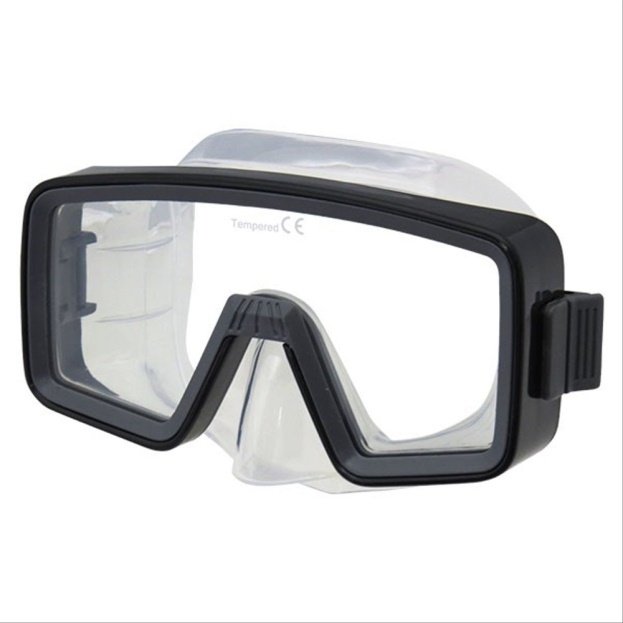
Single pane or single window masks have one continuous lens usually made of tempered glass. It’s a common choice among divers as it doesn’t have any frame running between the eyes. Depending on the fit, it leaves more space for the nose.
**Double pane lens mask
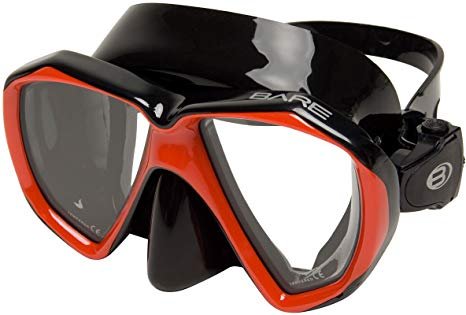
Double pane or two window masks have two separate lenses held on a frame. It allows the lenses to be closer to the diver’s face, which reduces the internal bulk of the mask. However, you have to ensure that the fit you’re getting doesn’t press too much on your nose bridge.
Take note that double pane dive masks are easier to equalize. If you’re worried about developing mask squeeze, this type might be the better choice.
**Pano-vision mask
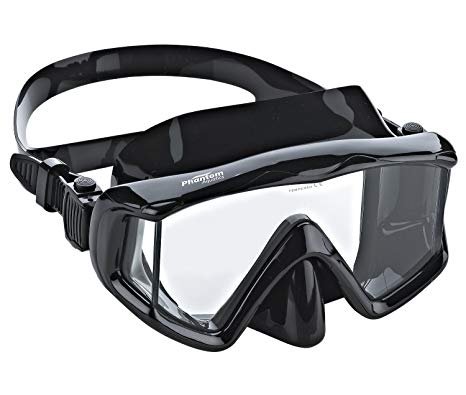
Pano-vision or side window masks have side windows that provide additional visibility. Aside from the lenses in front, there are additional glass windows on each side. This type of dive mask can be bulky and a bit more difficult to equalize underwater.
**No purge dive mask
A no purge dive mask can either be a single or double window type. It refers to the plain rubber nose construction of the mask. In this case, there’s no opening that will allow the diver the clear the mask if leaks happen. Nevertheless, it’s easier to equalize than the purge type.
**Purge dive mask
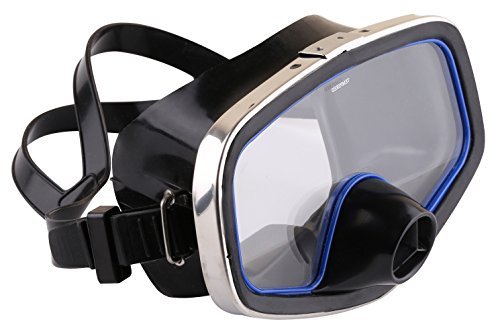
On the other hand, there’s the purge dive mask equipped with a purge valve inserted or built right on the nose portion. This feature allows the diver to clear the mask by exhaling into it. There are pros and cons to this type of mask.
Some divers complain that purge dive mask tends to leak when equalized improperly. When this happens, they would have to keep exhaling to keep the water from accumulating. During a deep dive, this can be problematic. Nevertheless, some divers are skilled enough to use a purge mask properly.
**Color correcting mask
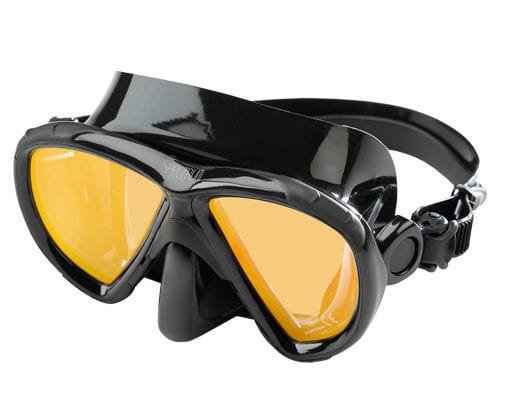
Color correcting mask has an orange or other colored lenses that help improve the object perception of the diver. Using this dive mask, the diver can pick up the color red better at the distance of 10 feet as well as the color yellow at 20 feet.
**Full face mask
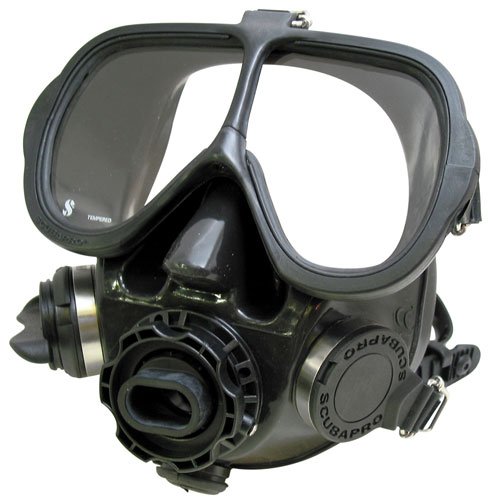
Lastly, there’s the full face mask. As the name suggests, this mask doesn’t usually have lens panes, though some are designed to have double panes. Also, it combines the mask and the air regulator in one so you wouldn’t have to hold on to the gear in your mouth.
Usually, divers use a full face mask so they can talk underwater through an underwater radio intercom system. And since this mask comes with advanced technology, expect that it will also be costly.
Strap Type
After you have decided on the type of lens and build, you should also consider the strap that will hold the mask in place. Basically, it comes in two types: neoprene or silicone rubber.
**Neoprene
Most divers prefer neoprene straps as it’s more comfortable and it doesn’t mess with their hair. Also, neoprene straps have Velcro fasteners.
**Silicone
If you don’t have hair and a neoprene strap keeps on slipping, a silicone rubber strap is the best choice. However, silicone straps can leach on fabric and neoprene materials so make sure that you keep it out of contact. Also, silicone rubber straps may get brittle over time, which will need an immediate replacement.
Clear vs. reflective lens
When it comes to the best scuba masks for small face, you should never purchase one with a reflective lens. Although it will not impede your line of sight, your diving buddy will fail to see your face. In short, your buddies will not know if you’re in the middle of hypoxia or if you’re doing alright unless you make hand signals.
With that, clear lenses are the ones to go. It’s safer for you, plus it improves communication with other divers.
High volume vs. low volume
A dive mask can come in either low volume or high volume designs. This pertains to the amount of space inside the mask once worn.
High volume mask offers an extended peripheral vision and a sense of space. However, it’s difficult to equalize and clear out of water if minor leaks occur. It also tends to be bulky for those who have small and narrow faces.
On the other hand, you can get low volume masks. For this one, the lens is closer to the face and with minimal space for air. Although it may feel tight, it’s easier to clear and equalize, reducing the risk of mask squeeze.
Scuba Mask Lens Types
Next, we have to consider the design and construction when purchasing the best scuba mask. This is a matter of suitability, visibility, and preference. Make sure that you check the following aspects:
**Frameless
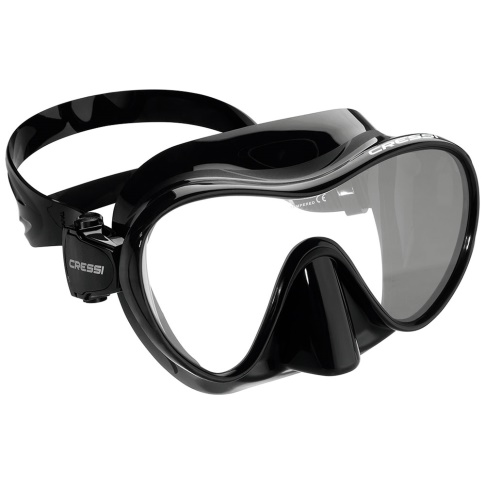
Frameless masks are those that don’t have any stiff piece of plastic that holds the lenses. The whole window or pane is bonded into the frameless mask skirt and wrapped around the face of the diver.
This design is lightweight and it offers better visibility. However, it may not fit all face types so always check the fit before purchasing one.
**Teardrop lens
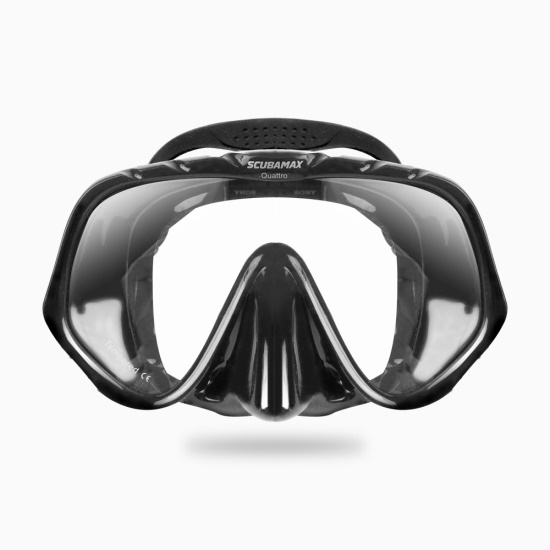
This type of lens has a teardrop shape so you can look down on your body during the dive. It adds visibility so you can easily read your gauges and use your straps, buckles, and other gears. Aside from that, a teardrop lens also allows you to check your fins as you ascend so you wouldn’t flip on other diver’s face. And for beginner divers, a teardrop lens reduces the feeling of claustrophobia.
**Wide lens
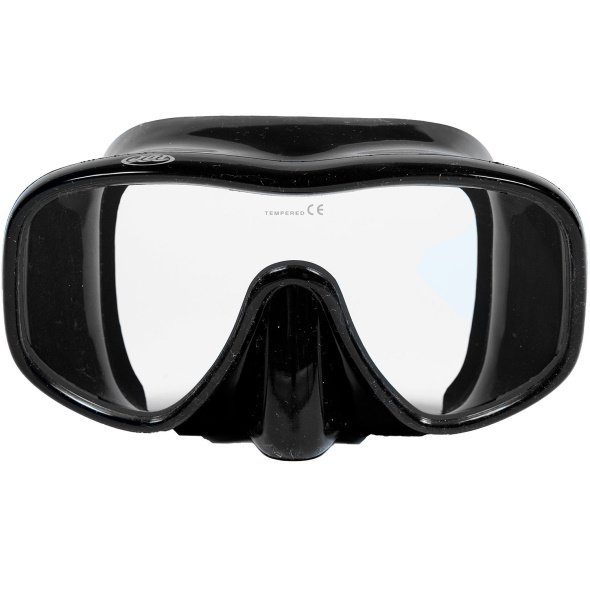
The wide lens on single window masks offers a better line of sight. However, you should know that it doesn’t offer the same ‘look down’ ability of the teardrop lens. Nevertheless, it’s a great choice if you want to see marine life better.
**Corrective lens compatible
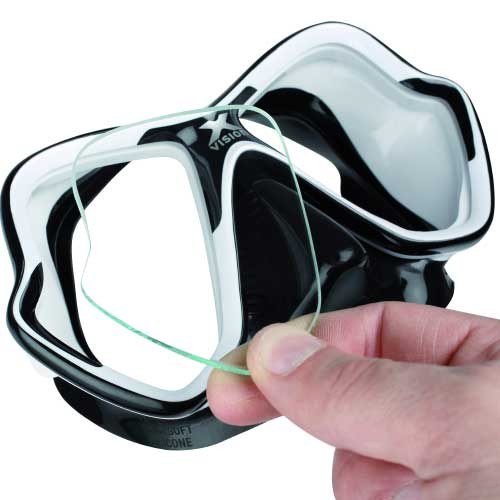
This is for divers who have to wear glasses or contact lenses during the dive. This type of lenses is compatible with stick-on magnifiers that you can purchase separately based on the lens grade prescription of your optometrist. Usually, a two window mask with a teardrop shape is the most compatible with the magnifiers. This way, you can dive without wearing contact lenses or eyeglasses per se.
**Female-specific design
A female-specific design is usually those with the narrower build. It can also accommodate deeper smile lines than standard dive masks. Other than that, the so-called female-specific design has no other difference to standard types. In fact, if you’re a guy with a narrow face, you can look for this type of scuba mask for a better fit.
How to Find the Best Scuba Masks for Small Faces
Aside from the technical aspects above, you should also consider the following points when purchasing the best scuba masks for smaller faces.
**Get the right fit
The fit of the dive mask is the most important. This ensures that you will have a comfortable drive while preventing leaks. But since scuba masks come in different shapes and sizes, it can be tricky to find one that suits your face.
The easiest way is to check the skirt. It shouldn’t have any gaps between the skirt and our skin. Also, try to smile and see how the mask will contour around your smile lines. There shouldn’t be any gaps at the corner of your mouth, no matter how small it looks.
Try to put the mask on your face and inhale deeply. This way, you can create a vacuum inside. Inhale only ones and see if the mask will keep the vacuum on. If it doesn’t, look for another one. Once you find a mask that remains pressurized, exhale to remove it from your face.
**Choose the best skirt color
The skirt of your mask is the silicone that surrounds the lenses to prevent leakage. It usually comes in clear or black color. But some also have different hues. However, this isn’t just about aesthetics. The skirt color also has something to do with lighting.
Clear skirts let more light in while black skirts reduce glare. Also, dark skirts reduce distraction associated with light or light patterns. Dark skirts also don’t show up dirt while white masks do.
**Look for a flexible nose pocket
The nose pocket should be suitable for the size of your nose. Also, it should be flexible, so you can pinch your nose to equalize the mask as you ascend and descend underwater.
For beginners, it’s best to opt for a no purge nose pocket. Some rookie divers aren’t comfortable feeling water around their nose, which may lead to panic attacks.
**Opt for a wide strap
For the strap of your mask, always look for one with two parallel strips at the back of your head. Single straps might be minimalist, but it’s not as comfortable and stable as two straps. Also, a wide strap is better as it prevents hair pulling while boosting the stability of the mask even under harsh underwater conditions.
**Invest in tempered glass instead of plastic
Plastic lenses fog up easily and it can’t endure the pressure of deep dives. Also, it may crack and leak during impact. It’s best to invest in a tempered glass lens that’s used by technical divers and professional divers. As much as standard glass lenses may work, it’s not as durable as tempered types.
**Do you have a mustache?
Diving with a mustache or beard wouldn’t be a problem in choosing the right fit for your mask. You can choose a mask the same way that another diver would be. However, before you dive, it’s best to shave the area under the nose a little. For beards, it’s advisable to thin it slightly so it wouldn’t get in the way of your gears.
For deep-sea divers, a full face mask is popular, especially, for those with beards and mustaches.
Scuba Mask Maintenance Tips
No matter how durable your dive mask is, you should practice proper maintenance so it will last long. The following are some of the tips we recommend:
**Always rinse it with fresh water
After diving, make sure that you rinse your mask with fresh water. The salinity of salt water can damage the silicone skirt if you store it without washing properly. Also, never put your mask under direct sunlight as it will make the rubber parts brittle.
**Don’t let silicone be in contact with neoprene
When storing your scuba diving mask, make sure that the neoprene strap doesn’t get in contact with the silicone skirt. Over time, the silicone skirt will leach into the neoprene, which will damage your mask. If you are planning to hang your diving gears for a long period, it’s best to remove the strap from the mask.
**Always use a defog solution before each dive
The moment you get your new mask, wash it and apply a defog solution. Make sure that your scrub the mask with toothpaste or other solutions that the manufacturer recommends. This will wash off the chemical coating used in the production of tempered glass. Take note that you only need to scrub the mask once. After that, you should apply a defog solution before each dive. This way, your mask will stay fog-free.
THE BEST SCUBA MASK FOR SMALL FACES – 2 Options
Are you looking for a great scuba mask suitable for small face? Here are two of our best picks together with a bonus prescription mask option for those with poor vision.
OUR #1 CHOICE
OUR TOP PICK: Scuba Pro Spectra Low Volume Window Dive Mask
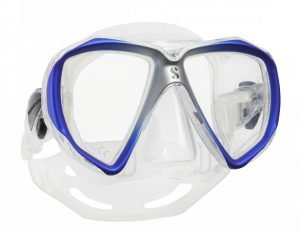
Product Name: Scuba Pro Spectra Low Volume Window Dive Mask
Product Description: If you’re looking for the best scuba mask for small faces, the ScubaPro Spectra Low Volume Dive Mask might be the best choice. It has an ultra-clear single lens that offers maximum wide field of view. This sports a double window design and a tempered glass window that lasts long even on the deepest dives. This is available in both color corrective and clear windows with a universal skirt design. This can fit all types of faces, even narrow and thin ones. Also, it boasts an EZ Equalize nose pocket and a low volume design so you can easily equalize during ascend and descend. Moreover, the Scuba Pro Spectra has mirrored lens that reduces the glare while you’re underwater. Although it comes with a higher price tag than other masks, it’s very clear and can be used for professional diving.
- Skirt Quality
- Equalization
- Lens Quality
- Visibility
Overall
Summary
It also has bold frame colors that add a stylish touch on your gears. Take note that you should only scrub or wash this mask with non-abrasive products to prevent damages on the painted areas.
Aside from that, this mask also comes with push-button buckles attached to the skirt. You can adjust it easily to get the best fit.
If you are to scrub this mask to apply a defog solution, just use mild dish soap and water.
Pros
✔️Tempered glass lenses
✔️EZ Equalize nose pocket
✔️Mirrored lenses for reduced glare
Cons
❌Doesn’t give a ‘look down’ view but not a biggie
RUNNER-UP: Cressi Panoramic Wide View Mask
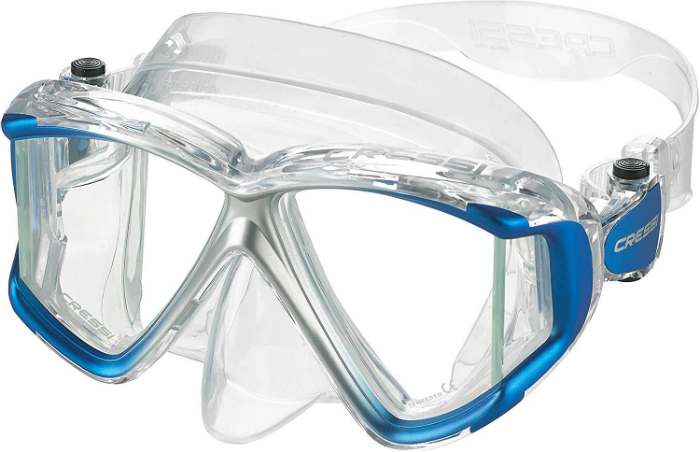
If you want to enjoy the underwater view, the Cressi Panoramic Wide View Mask might be the best scuba mask for tiny faces. It has a pano-vision lens with wide, anatomical silicone rubber strap as well as a double feathered silicone skirt. Aside from that, it has a one-hand nose pocket for hassle-free equalization.
Moreover, this is a four-lens, tempered glass mask that’s lightweight and bears a medium volume. Also, it has an anti-splash dry top design with valve seals tube, so you can use the mask for snorkeling as well.
Overall, the Cressi Panoramic Wide View Mask is ideal for recreational and casual dives. It’s more affordable than the Scuba Pro model above and offers a more-than-decent performance underwater. And since it’s made by Cressi, you can count on the high quality of this dive gear.
If you have a small mouth and a narrow face, this Cressi dive mask is a great buy. Although you may not use the snorkel tube too often, it comes handy for vacations.
What we really like the most about this mask is it doesn’t fog up. Just scrub the lenses with dish soap before diving and you’re good to go. But to be sure, you can always apply a defog solution.
✔️Tempered glass lens
✔️One-hand nose pocket for easy equalization
BONUS for those who wear eyeglasses: Promate Prescription Purge Mask Dry Scuba Mask Combo
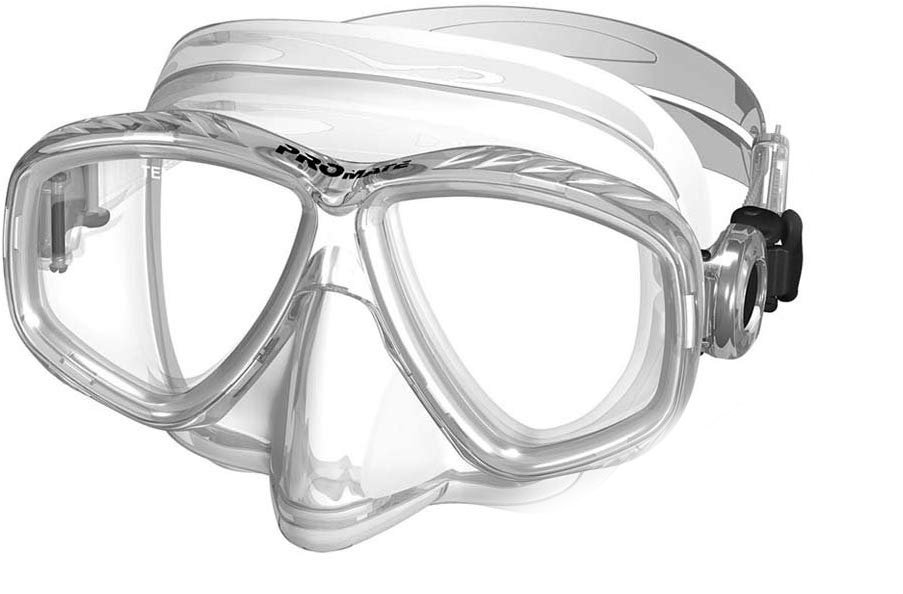
Although it didn’t make our top two picks, we still recommend the Promate Prescription Purge Dive Mask. Aside from the mask, you can also purchase prescription lenses that match the mask lens. Promate has prescription lens for near sight (-1.0 to -10.0) and far sight (+1.0 to +4.5). Both have increments of 0.5.
Meanwhile, the mask has a purge skirt system that allows you to clear out excess water. It sports a patented and channeled skirt that removes bubbles from your view. Also, we like the dimpled nose pocket that allows for one hand equalization.
Also, it has a buckle system attached to the skirt which allows a swivel motion so it is easy to adjust the fit accordingly. It comes with a snorkel which comes handy in some occasions.
Overall, this prescription mask is value for money. Even PADI certified divers use this, though you may want to switch for a better strap.
✔️Purge skirt system
✔️Dimpled nose pocket
Frequently Asked Questions
Q: Does mask squeeze go away?
A: Mask squeeze or facial barotrauma doesn’t have a medical cure, but it will go away over time. This condition happens when the diver fails to equalize the pressure inside the mask. As he or she descends, the water puts pressure on the body, while the air inside the mask fails to keep up. Divers with this condition should avoid diving until the condition has fully healed.
Q: How do you keep a diving mask from fogging up?
A: If you hate foggy diving masks, avoid purchasing plastic lenses. Another thing that you can do is applying mask defoggers before you dive. This will give your mask a shield against the changing temperatures underwater which will may fogging.
Q: Can scuba divers have beards?
A: A lot of divers have beards. This is actually more of an issue of convenience since long beards may get in tangle with the diving equipment. Also, some are worried that their beard may get frizzy or dry due to prolonged immersion to saltwater. Other than that, there shouldn’t be any problem about having a beard when diving. You can use a beard seal to keep the beard in place.
Q: Why does my dive mask leak?
A: It’s possible that the skirt of the dive mask isn’t properly sealed, which allows water to seep through your face. It’s important that you check your mask for leaks before diving to prevent potential danger underwater.
Q: Can you dive with glasses?
A: Instead of wearing eyeglasses or contact lenses, divers with poor eyesight purchase a corrective lens stick-on that’s compatible with their diving mask. This way, they can see clearly underwater without their eyeglasses.
Final words
Scuba mask for small faces is ideal so you will stay safe and comfortable during your plunge. It’s also crucial that you choose the right design, material, and single lens type to suit your underwater activities. Take note that each dive mask type has a specific purpose so make sure that consider it well.
Most of all, the fit of your dive mask is crucial. For divers with narrow faces, always look for one that won’t leak even under considerable depth. We highly recommend Scuba Pro Spectra as it comes with tempered lenses as well as a nose pocket that allows easy equalization. It might cost a lot than most budget masks, but it’s definitely worth the splurge if you’re a regular diver. Nevertheless, the Cressi Dive Mask is also a great choice if you want a better view of the underworld.
